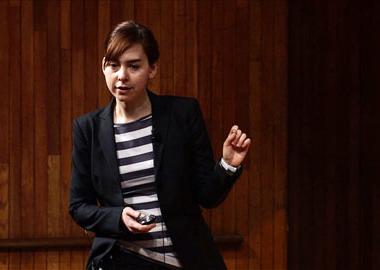 Three “young Turks” of computation science, in the words of moderator John Guttag, discuss recent, and quite varied, research.
Three “young Turks” of computation science, in the words of moderator John Guttag, discuss recent, and quite varied, research.The traditional approach to characterizing neurological diseases in large populations assumes “there is an average brain that represents us all,” says
Polina Golland, and that we are all “noisy” iterations of this central type. But in fact there is such great variability of brains in a normal population that it is hard to catch the “subtle differences induced by varied diseases.” So Golland has “put the problem upside down,” and using neuroimaging, developed models for the developing brain. Using 400 brain images of subjects from 18-96 years of age, Golland has discovered three templates that correspond to the young, middle-aged and older brain. Since her algorithms are “blind to the ages,” older subjects might possess an anatomically younger brain, with lots of gray matter and smaller ventricles. Structures in the older brains correlate in clinical populations to a higher risk of developing Alzheimer’s disease, and Golland believes her methodology of linking brain structure to function will help in diagnostics and in surgery.
Dina Katabi may have found an answer to the annoying
glitches and stalls that seem to plague mobile video users. Whether due to changes in distance or something as simple as raising the handheld device up or down, wireless video suffers from a performance cliff, working really well, and then suddenly dropping off. This is because the current coding system uses bits of information for compressing video and for error protection, which means small errors can result in massive drop off in performance. Katabi’s solution, called SoftCast, joins the two codes that compress and error correct the video into a single, linear stream of information. If there is a small perturbation in video code, the impact on channel quality is barely noticeable. Katabi shows a convincing comparison of her scheme versus the MPEG4 standard on a smart phone, and SoftCast is the clear champion, with video quality “changing smoothly with channel quality” as the phone moves farther away from the transmitter.
The ‘wisdom of crowds’ on the Internet can be applied to solve all kinds of problems that are too hard for software alone, says Rob Miller. He shows how “highly elastic human resources” -- what he calls “crowd computing” --are being used to tackle a variety of tasks, including translating someone’s messy handwriting, and even editing a paper. With the help of Amazon’s Mechanical Turk service, where vast numbers of people contract to perform tiny tasks for equally tiny amounts of money, it is possible to create online services that proofread, alter content, and shorten documents. With the right algorithms shaping user interaction, a mass of helping hands can make multiple passes for proper grammar, improved sentence structure and length. Repeated iterations by the crowd to “find, fix and verify,” says Miller, can produce results equivalent to the work of a single professional proofreader—but in minutes, and at a fraction of the cost....Read the full article/Watch Video
The ‘wisdom of crowds’ on the Internet can be applied to solve all kinds of problems that are too hard for software alone, says Rob Miller. He shows how “highly elastic human resources” -- what he calls “crowd computing” --are being used to tackle a variety of tasks, including translating someone’s messy handwriting, and even editing a paper. With the help of Amazon’s Mechanical Turk service, where vast numbers of people contract to perform tiny tasks for equally tiny amounts of money, it is possible to create online services that proofread, alter content, and shorten documents. With the right algorithms shaping user interaction, a mass of helping hands can make multiple passes for proper grammar, improved sentence structure and length. Repeated iterations by the crowd to “find, fix and verify,” says Miller, can produce results equivalent to the work of a single professional proofreader—but in minutes, and at a fraction of the cost....Read the full article/Watch Video
For more techical information visit our sister website www.engineeringmaintenance.info or for equipment procurement please visit www.engineeringtrader.com

